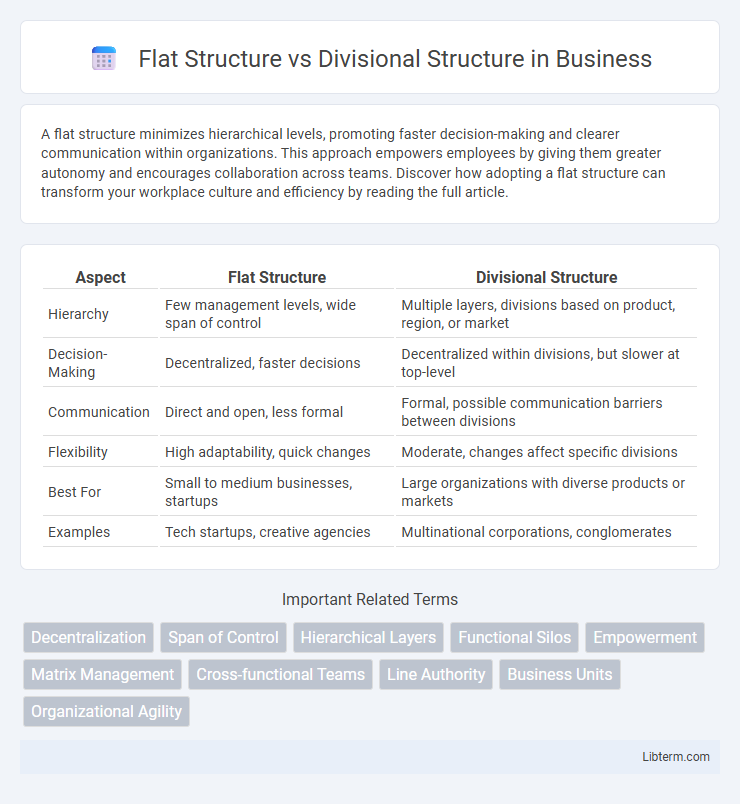A flat structure minimizes hierarchical levels, promoting faster decision-making and clearer communication within organizations. This approach empowers employees by giving them greater autonomy and encourages collaboration across teams. Discover how adopting a flat structure can transform your workplace culture and efficiency by reading the full article.
Table of Comparison
| Aspect | Flat Structure | Divisional Structure |
|---|---|---|
| Hierarchy | Few management levels, wide span of control | Multiple layers, divisions based on product, region, or market |
| Decision-Making | Decentralized, faster decisions | Decentralized within divisions, but slower at top-level |
| Communication | Direct and open, less formal | Formal, possible communication barriers between divisions |
| Flexibility | High adaptability, quick changes | Moderate, changes affect specific divisions |
| Best For | Small to medium businesses, startups | Large organizations with diverse products or markets |
| Examples | Tech startups, creative agencies | Multinational corporations, conglomerates |
Introduction to Organizational Structures
Organizational structures define how roles, responsibilities, and authority are distributed within a company, impacting communication and decision-making processes. A flat structure features minimal hierarchical levels, promoting open communication and faster decision-making, ideal for small or agile organizations. In contrast, a divisional structure groups functions into semi-autonomous units based on products, markets, or geography, enhancing focus and accountability in large, diversified companies.
Understanding Flat Structure
Flat structure promotes a streamlined organizational hierarchy with few or no middle management levels, enabling faster decision-making and improved communication across teams. This structure enhances employee empowerment by allowing greater autonomy and direct involvement in operational processes, which boosts innovation and responsiveness. Companies adopting flat structures often experience reduced operational costs and increased flexibility, particularly beneficial for startups and small enterprises aiming for rapid growth.
Key Features of Flat Structure
Flat structure features minimal hierarchical levels, promoting open communication and faster decision-making within organizations. Employees in flat structures often experience greater autonomy and closer collaboration with management, enhancing innovation and responsiveness. This structure is ideal for small to medium-sized businesses seeking agility and reduced bureaucracy.
Overview of Divisional Structure
Divisional structure organizes a company into semi-autonomous units based on products, geography, or customer segments, enabling focused management and faster decision-making. Each division operates as a separate entity with its own resources and functions, facilitating accountability and flexibility in response to market demands. This structure enhances specialization but may increase operational costs due to duplicated resources across divisions.
Key Features of Divisional Structure
Divisional structure organizes a company into semi-autonomous units based on products, markets, or geographical regions, promoting focused specialization and accountability. Each division operates with its own resources including marketing, sales, and production, enabling faster decision-making tailored to specific customer needs. This structure enhances flexibility and responsiveness while allowing headquarters to oversee overall strategic direction.
Flat Structure: Advantages and Disadvantages
Flat structure promotes faster decision-making and improved communication by minimizing hierarchical layers, enhancing employee autonomy and motivation. Reduced bureaucracy and lower management costs lead to increased flexibility and innovation, making it ideal for small to medium-sized organizations. However, flat structures may result in role ambiguity, managerial overload, and challenges in scaling operations effectively, limiting their suitability for larger or more complex businesses.
Divisional Structure: Pros and Cons
Divisional structure organizes a company into semi-autonomous units based on product lines, geography, or markets, enhancing focus and accountability within each division. This structure allows for faster decision-making and better adaptation to local conditions but can lead to duplication of resources and higher operational costs. Challenges include potential conflicts between divisions and difficulties in maintaining a unified corporate culture.
Flat vs Divisional: Suitability for Businesses
Flat structure suits small to medium-sized businesses seeking quick decision-making and close employee collaboration, enhancing agility and innovation. Divisional structure benefits large, diversified corporations needing clear accountability and autonomy across distinct product lines or regions, promoting specialization and efficient resource allocation. Choosing between flat and divisional depends on business size, complexity, and the need for flexibility versus structured management.
Real-World Examples and Case Studies
Flat organizational structures, exemplified by companies like Valve Corporation, promote quick decision-making and foster innovation by minimizing hierarchical layers. In contrast, divisional structures, as seen in General Electric, enhance operational efficiency by grouping business units based on product lines or geographic regions, allowing for specialized management and accountability. Case studies reveal that technology startups benefit from flat structures to maintain agility, while large multinational corporations leverage divisional frameworks to manage complex operations effectively.
Choosing the Right Structure for Your Organization
Choosing the right organizational structure depends on the size, goals, and complexity of the business. Flat structures enhance communication and agility in small to medium-sized enterprises by reducing hierarchical layers, while divisional structures offer clear specialization and accountability suited for large, diversified corporations. Evaluating operational needs, decision-making speed, and departmental interdependence is critical for aligning structure with organizational strategy and growth objectives.
Flat Structure Infographic

 libterm.com
libterm.com